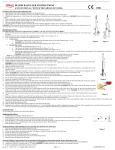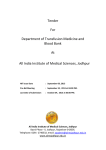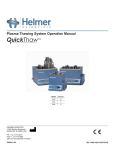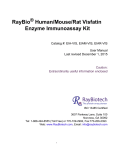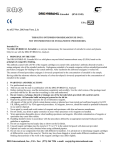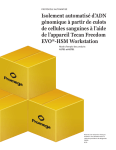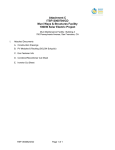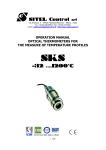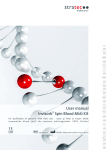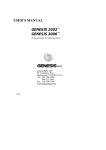Download User Manual
Transcript
BLOOD BAGS USER INSTRUCTIONS (K2 -TOP AND BOTTOM SYSTEM) DESCRIPTION For the collection, separation and storage of leukoreduced RBC, plasma and platelets. INDICATIONS See, “Guide to the preparation, use and quality assurance of Blood Components.” GENERAL PREPARATIONS BEFORE USAGE 1. Open the outer wrap at the tear notches and remove one blood bag system 2. Apply blood pressure cuff or tourniquet on donor’s arm, identify venipuncture site and release the cuff or tourniquet. 3. Disinfect the venipuncture site. Cover the area with sterilized gauze strip and do not touch until the time of venipuncture .CAUTION: Beware of iodine sensitive donors! 4. Before venipuncture, inspect the blood bag system; tubing, and needle for visual defects and discoloration 5. Signs on the needle protector and hub should be the in the same line. Apply some pressure to determine any leakages. 6. Place the collection bag below the level of donor's arm 7. The anticoagulant and additive solutions should be checked for containing appropriate volume, color or particule contaminants. CAUTION: While opening the blood bag system, blood taking tube should be held from needle protector not from the needle safety cover. Pay attention not to lock the needle safety cover before collection of blood by mistake. USER INSTRUCTIONS BLOOD COLLECTION: IF SAMPLING BAG SYSTEM IS USED FOLLOW NUMBER 1-4, IF NOT CONTINUE WITH NUMBER 5: 1. Before the needle protector is uncapped close the clamp on the line connected to collection bag. If the bag system has a breakaway part there is no need to close the clamp. 2. Break the break-away part on the tube to the sampling bag/holder. (Figure 1, No: 2, Figure 2, No: 3). 3. Follow the following steps according to the sampling bag system: a. Tubing System i. Blood samples; sampling tubes are inserted into the tube holder and necessary blood is taken (Figure 1, No: 3). Figure 1 Figure 2 ii. CAUTION: Take the samples to bigger tubes first. iii. The clamp on the tubing to the bag is opened and blood taking starts. (Figure 1, No: 1) b. Sampling Bag System; i. Take blood to the sampling bag (Figure 2, No: 5), ii. The clamp on the tubing to the sampling bag is closed. (Figure 2, No: 2), iii. The clamp on the tubing to the bag is opened and blood taking starts. (Figure 2, No: 1) iv. Sampling bag is placed in palm in a position of sampling bag tube holder is to be stayed below. Sample tubes are inserted in tube holder connected to the sampling bag and sufficient blood sample is taken.(Figure 2, No:4) CAUTION: Sample blood in the sampling bag should immediately transferred to the tubes otherwise they get coagulated. NOTE: After sampling, break the breakaway part on the tubing to collection bag for the systems with donor line breakaway 4. The tube with the tube holder is hanged on to donor’s wrist in a way not to compress the needle, continue with number 9. 5. If the blod bag system does not have a sampling bag/samling port, put a temporary clamp or knot to blood taking tube. 6. Reapply tourniquet or inflate blood pressure cuff until previously selected vein is prominent again. 7. Hold the needle from marked side. To remove the needle cap, twist to break the seal between the needle and its cap and remove it by sliding it down the axis of the needle. CAUTION: Bu sure not to touch the cannula! 8. Apply the venipuncture immediately. Venipuncture is very important for a non-coagulated blood. 9. Strap the needle to the donor’s arm. 10. Mix blood and anticoagulant gently and periodically (approximately in every 45 seconds) during collection. If a mixer or a collection system is used, please refer to their operator’s manual. 11. Make sure there is continuous blood flow. If there is continuous, adequate blood flow and constant agitation, blood collection is expected to be completed under 12 minutes. CAUTION: If it s above 12 minutes, collected blood may not be suitable for Platelets, Fresh Frozen Plasma or Cryoprecipitate AHF. 12. Collect the quantity of blood within the limits indicated on the bag label. Monitor the blood being drawn. 13. After blood collection is finished, blood collection mixer collects the desired blood and stops the collection by clamping the blood collection tube. 14. Stop the blood taking and agitating device, and after opening the clamp of the device; 15. Loosen the tourniquet or deflate the pressure cuff. Figure 3 16. When blood taking is done, to remove the needle hold the hub with one hand between the thumb and index finger while the other hand holding the sterile gauze and pull the hub without exerting pressure completely. Let the donor keep sterile gauze on the point of entry of the needle into vein. 17. Hold the needle with one hand as the tip stay at the upper position; wait for flowing off the blood to bag in the blood taking tube 18. The clamp on the tube to the bag is closed after that step. Put a knot on the systems without sampling bag. CAUTION: When the needle is locked if the clamp is not closed there is a risk of blood flushing from the needle safety cover. 19. For the blood bag systems with needle safety cover, while holding the needle with one hand hold the needle safety cover with the other one, than leave the needle, pull the needle to the safety cover by pulling the tube under the safety cover and be sure that it is locked (Figure 3, No:6). CAUTION To prevent accidental injuries or contamination of the personnel, insert the needle into the locked system or throw it to the medical waste. 20. The blood taking tube is closed from under the Y port with tube sealing device and the needle is removed from the system. Caution: Throw locked needle kit to the medical waste. Figure 4 21. Strip donor tubing as completely as possible into bag, starting at seal. Work quickly, to prevent the blood from clotting in the tubing. Invert bag several times to mix thoroughly; then allow tubing to refill with anticoagulated blood from the bag. Repeat this procedure twice. (Figure 4) 22. For cross match purposes, seal the tubing attached to the collection bag into segments leaving a segment number clearly and completely readable. The closest segment number to the collection bag should always remain attached to the bag for identification 23. Check the blood bag again for any faults. 24. Make sure all the donor information required is filled out on the label of the blood bag. 25. Immediately after collection, whole blood should be placed at 1-6 °C in a blood bank refrigerator which is designed for this purpose. If platelets will be separated, do not cool the blood but wait under 20-24 °C for a min. of 1 hour with 45 angle. For gaining fresh freezed plasma and platelets finish all the steps within 8 hours after collection. COMPONENT SEPARATION: K2 Bags: (used for separation of PLTs by reducing redcells, plasma and BC) 1. Place the bags into centrifuge bucket ensuring that the break-off part to stay at the upper position. Caution: Place the filter into the housing. Proper positioning of the bags will prevent burst of the bags during centrifugation. 2. If taken blood is to be used as whole blood instead of separating to components, break-off part of the primary bag is broken and whole blood is transferred to 500 ml transfer bag in separator. 3. Centrifuge Top&Bottom Triple bag at 3500 g for 20 mins under +4° C. Centrifuge Top&Bottom Quadruple Bag at 4000 g for 30 mins under 22° C. Caution: Centrifuge settings may vary according to the centrifuge brand. Figure 5 4. After centrifugation, place the main bag in the automated separator device. If the quadruple system is used, clamp the tubing of the platelet bag. 5. Use the blood component separator according to it separator using manual. 6. First, the break-off part of the main bag and then the break-off part of the other bag containing SAG-Mannitol solution shall be broken. (Figure 5) 7. Automated separator transfers plasma to plasma bag and Red Cells to SAG-M bag allowing Buffy Coat to remain in the main bag. 8. After the process is completed seal the transfer bags containing Platelet and Red Cells suspension with a tubing sealer and separate from the system. 9. Place the Red Cells immediately at 1-6°C in a blood bank refrigerator which is designed for this purpose. 10. Place plasma to the freezer for storing. If blood is separated in 6 hours, it can be stored at -18 C/-25 C for 3 months, and -30 C/-40C for 6 months and at lower temperatures for 12 months. kt_kk_7 - 58760 / Rev: 3 / Issue Date: 10.08.2018 Page 1 / 2 CAPA NO: 84/18 11. If quadruple bags are used, seal the main bag containing Buffy Coat with a platelet clamp from the middle, mix the bag thoroughly and wait for 1 hour. 12. Centrifuge the primary bag and the bag labeled 5 at 500g for 6 minutes at 20°C. Caution: Centrifuge settings may vary according to the centrifuge brand used. 13. Platelets are transferred to the platelet bags in the automatic separator. Warning: After centrifuge, platelets are separated immediately. 14. Platelets may be stored in transfer bags made of PVC (TOTM) in an agitator with incubator for up to 5 days. TRANSFUSION: 1. Inspect the container and blood for any defects. 2. Before transfusing the blood, make sure that serological test results are acceptable, cross match test results match with the recipient. If appropriate, apply cross match again at bed side. 3. Use transfusion set compatible with ISO EN 1135–4. 4. Hold the top part of the T port with one hand and bag from the bottom part of T port with other hand, and twist of the upper part by 270 (Figure 6) 5. Keep holding the bag from T port, remove the cap of the transfusion spike with other hand. 6. Insert the spike by ¾ of its length into outlet port. Do not touch the spike of the transfusion set and open outlet port to prevent contamination. 7. After inserting the spike, squeeze the bag to the level that transfusion set filter is filled with blood. 8. Hook the bag from its holder. GENERAL CAUTIONS During storage and transportation; 1. During shipment, up to two blood bags shippers shall be carried at the same time manually or on a trolley. Parcels should not be dropped and/or crushed and should be loaded in a way to prevent fall over. 2. In the warehouse, up to seven parcels can be stored on top of each other and in a way to prevent fall over. Before opening overwrap; 3. Store the overwrapped bags at clean, dry and cool places. 4. Do not use if there is visible sign of deterioration on the overwraps. 5. Blood bags are packed with sterilized. After opening overwrap; 6. Store the bags in their outer wraps at clean, dry and cool places. 7. Bag should be used within 10 days after removal of the transparent overwrap. Before usage; 1. This product is intended to be used by certified Blood Bank personel in the Blood Bank 2. Store the closed overwraps at clean, dry and cool places. 3. Intended for human blood and blood components. 4. Sterile and non pyrogenic - Steam sterilization. 5. Do not use unless solutions are clear. 6. Do not use if there is visible sign of deterioration on the bags. 7. Protect the bag and tubing from sharp objects. 8. Do not use if needle protector is opened. Bars on the needle should be in the same line. (Figure 7) 9. Do not recap the opened needles. 10. Do not use if fluid path closures are loose and not intact 11. Do not vent. 12. Store blood between 1–6 0C. 13. Do not add medication to blood. 14. Cross match the contents of the bag with recipient before transfusion. 15. Use transfusion sets in compliance with ISO EN 1135–4. 16. Mix thoroughly before use and if necessary, store under controlled conditions to achieve the appropriate temperature. When frozen, plastic is more fragile. After usage: Single use only, Throw to medical waster after use. Caution: In case of reuse, there is infection risk. Figure 6 Figure7 CAUTION: This medical device contains di(2-ethylhexyl) phthalate (DEHP). Some subpopulations of patients may be at increased risk due to exposure to DEHP following transfusions, these patients are infants undergoing exchange transfusion, children undergoing certain medical procedures and adults undergoing ECMO (extracorporeal membrane oxygenation). It has been indicated by animal experiments that nonhuman primates are less sensitive than rodents to DEHP exposure following oral administration also. Medical procedures should not be avoided however, as the benefits outweigh any possible health risks associated with DEHP exposure. Please refer to current literature to make an informed decision. KANSUK LABORATUARI SANAYİ VE TİCARET A.Ş. Beşyol Mah. Eski Londra Asfaltı No: 4 34295 Sefaköy, İSTANBUL / TÜRKİYE Tel: +90 212 592 15 76, Faks: +90 212 580 37 72, www.kansuk.com, e-mail: [email protected] kt_kk_7 - 58760 / Rev: 3 / Issue Date: 10.08.2018 Page 2 / 2 CAPA NO: 84/18




